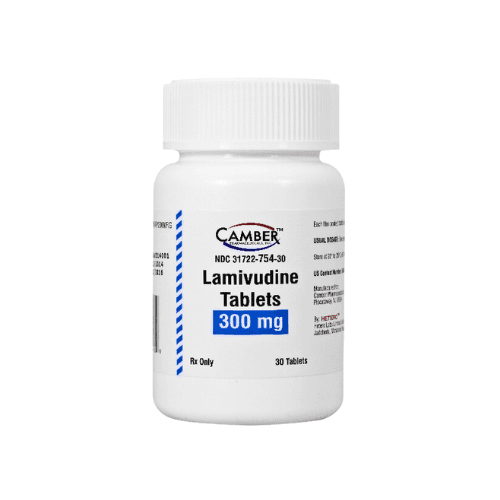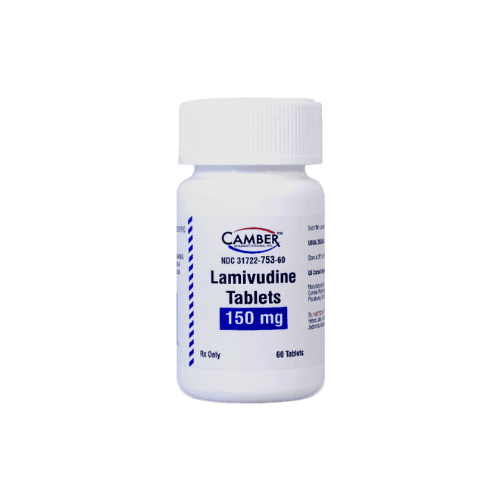Shipping with this method takes 3-5 days
Lamivudine Tablets for Hepatitis B and HIV
Price range: $251.99 through $252.99
Secure Encrypted Payments
Lamivudine is an antiviral used for chronic hepatitis B and for HIV treatment in combination regimens. This page explains approved uses, strengths, safety basics, and how to take it. It also covers access to Canadian pricing with US delivery from Canada, including options if you pay without insurance.
What Lamivudine Is and How It Works
YouDrugstore is a licensed Canadian pharmacy in Manitoba. Pharmacists review prescriptions before dispensing.
This medicine is a nucleoside reverse transcriptase inhibitor. It blocks viral replication in hepatitis B virus and in HIV when used as part of antiretroviral therapy. In HIV care, it is combined with other agents to help reduce viral load and support immune function. In hepatitis B, it may help lower liver inflammation and viral DNA levels when used under a prescriber’s guidance.
Some brand references you may encounter include Epivir-HBV® for hepatitis B and Epivir for HIV. Generics are widely used and follow the same active ingredient and labeled indications.
Who It’s For
This treatment is used for adults with chronic Hepatitis B and for adults and children with HIV as part of combination therapy. It is not sufficient alone for HIV management. People with known hypersensitivity to this ingredient should not use it. Those with significant kidney impairment, a history of pancreatitis, or advanced liver disease should discuss risks and monitoring with a healthcare professional before starting.
Pregnancy and breastfeeding considerations vary by clinical situation. Your prescriber will weigh benefits and risks using current guidelines. Children may receive weight-based dosing under specialist care.
Dosage and Usage
Dosing depends on the condition, age, and kidney function. For chronic hepatitis B, prescribers commonly use once-daily dosing. For HIV, it is used within a combination regimen. Many regimens use once-daily dosing of lamivudine 300 mg tablets or an equivalent split dose. Pediatric dosing is typically weight-based and follows the official label.
Take tablets with or without food. Try to take it at the same time each day to support consistent levels. Follow your prescription label and your clinician’s guidance. Do not change doses or stop therapy without medical advice, especially if you have both HIV and hepatitis B.
Strengths and Forms
Availability can vary by manufacturer. Common presentations include:
- lamivudine 100 mg tablets (often used for hepatitis B)
- 150 mg tablets
- 300 mg tablets (commonly used in HIV regimens)
- Oral solution 10 mg/mL
Generic and brand products may differ in packaging, color, or bottle size, but contain the same active drug when matched by strength.
Missed Dose and Timing
If you miss a dose, take it when you remember unless it is close to your next scheduled time. If it is close, skip the missed dose and resume your regular schedule. Do not take two doses at once. If vomiting occurs shortly after a dose and you are unsure what to do, check the official label or contact your prescriber or pharmacist for advice.
Storage and Travel Basics
Store tablets tightly closed at room temperature and protect them from moisture. Keep all medicines out of reach of children. For the liquid form, follow the package instructions and your pharmacist’s advice for storage. If you use the liquid, you may see it labeled as lamivudine oral solution 10 mg/mL; use the provided measuring device for accuracy.
For travel, carry your medication in the original labeled container. Pack enough for your trip plus a small buffer in case of delays. Keep a copy of your prescription or a medication list for security checkpoints. Avoid storing medicine in checked baggage or in hot cars. If your regimen includes multiple antivirals, use a daily pill organizer to support adherence.
Benefits
This therapy has well-established roles in managing chronic hepatitis B and in HIV combination treatment. Once-daily tablet options can support routine use. An oral solution may help those who have difficulty swallowing tablets. When taken as directed alongside other antiretrovirals for HIV, it contributes to lowering viral load as part of the overall regimen.
Side Effects and Safety
- Headache
- Nausea or vomiting
- Diarrhea
- Fatigue
- Abdominal discomfort
- Cough or sore throat
- Rash
Serious effects are uncommon but can occur. These include lactic acidosis and severe hepatomegaly with steatosis, pancreatitis, and hepatitis flares when stopping therapy in patients with hepatitis B. Report symptoms such as unusual tiredness, severe stomach pain, persistent nausea, rapid breathing, or jaundice to a healthcare professional right away. In HIV care, combining with other medicines that increase hypoglycemia risk is not typical; however, if your broader regimen includes agents with glycemic effects, your clinician may monitor accordingly.
Drug Interactions and Cautions
Avoid concurrent use with emtricitabine-containing products because of overlapping activity. Sorbitol-containing solutions may reduce absorption; limit or avoid them during therapy as advised. Trimethoprim/sulfamethoxazole can increase drug levels; your prescriber will determine if adjustments or monitoring are needed. Cladribine coadministration is generally not recommended due to potential reduced effectiveness of cladribine.
Tell your healthcare professional about all prescription and nonprescription medicines, vitamins, and herbal products you take. This includes antacids, laxatives, and cough syrups that may contain sorbitol. For people with liver or kidney disease, extra caution and lab monitoring are common. Learn more about organ-related considerations in our article on Drug Caveats With Liver And Kidney Disease.
What to Expect Over Time
In chronic hepatitis B, your clinician may check liver tests and viral markers at regular intervals. Do not stop suddenly, as flares can occur after discontinuation. In HIV, this medicine is one part of a complete regimen; consistent daily use of all components is essential. You may not feel different day to day, so routine lab follow-up is key. If you need adherence support, consider alarms or a pillbox and discuss options with your care team. For screening and community resources, see our piece on National HIV Testing Day 2025 Get Tested Know Your Status.
Compare With Alternatives
For chronic hepatitis B, prescribers may consider nucleos(t)ide analogues with higher resistance barriers. Two commonly used options are Viread® (tenofovir disoproxil fumarate) and Baraclude® (entecavir). Selection depends on kidney function, resistance history, and coexisting conditions. Your specialist will choose based on guidelines and your health profile.
In some cases, patients may transition from or to Epivir-HBV 100 mg tablets under a prescriber’s plan. For HIV, combination therapy options are broad, including integrase inhibitor–based regimens and fixed-dose combinations. Discuss the full regimen design with your clinician to ensure drug–drug compatibility and long-term durability.
Pricing and Access
We source Canadian options to help you compare costs and formulations. Many people look for a lamivudine cash price to budget for refills or to plan multi-month supplies. You can review current options and request a quote; we provide US delivery from Canada on valid prescriptions. For occasional offers, visit our Promotions page. Checkout is encrypted to protect your information.
Availability and Substitutions
Stock and manufacturers can vary. If a specific tablet is not available, your prescriber may recommend an equivalent strength from another maker. Some patients ask about Epivir 300 mg tablets; your clinician can advise whether a branded or generic product is appropriate in your situation. If a formulation is temporarily unavailable, your prescriber may suggest an alternative antiviral or an adjusted plan without interrupting therapy.
Patient Suitability and Cost-Saving Tips
Good candidates can swallow tablets or use the liquid, follow a daily schedule, and complete routine lab monitoring. Those with kidney impairment may need adjusted dosing managed by a clinician. People with a history of pancreatitis or severe liver disease should be evaluated carefully. Consider these practical tips to help lower out-of-pocket spending and simplify treatment:
- Multi-month fills: Ask your prescriber about 60- or 90-day supplies.
- Generic first: Use generics when appropriate for lower pricing.
- Aligned refills: Refill your medicines together to reduce pharmacy visits.
- Travel-ready: Keep an extra small reserve for trips and delays.
- Medication list: Carry a list to avoid interactions and duplications.
Questions to Ask Your Clinician
- Which condition are we targeting and what is the treatment goal?
- How does my kidney function affect dosing and monitoring?
- Should I avoid emtricitabine, sorbitol, or other specific products?
- What labs will you check and how often?
- If I also have hepatitis B and HIV, how will you plan changes safely?
- What signs of serious side effects should prompt immediate contact?
Authoritative Sources
For detailed prescribing information, consult these official resources:
Related Learning
Explore more topics on treatment choices and safe use: an overview of Antivirals, insights on HIV care, and facts about Drug Interactions The Top Interactions That Should Be On Your Radar.
Ready to request your prescription? Place your order with prompt US delivery from Canada and temperature-controlled handling when required. This information is not a substitute for medical advice; always follow your prescriber’s instructions and the official label.
Express Shipping - from $25.00
Prices:
- Dry-Packed Products $25.00
- Cold-Packed Products $35.00
Shipping Countries:
- United States (all contiguous states**)
- Worldwide (excludes some countries***)
Standard Shipping - $15.00
Shipping with this method takes 5-10 days
Prices:
- Dry-Packed Products $15.00
- Not available for Cold-Packed products
Shipping Countries:
- United States (all contiguous states**)
- Worldwide (excludes some countries***)
How is this medicine used for hepatitis B?
For chronic hepatitis B, clinicians commonly prescribe once-daily dosing and monitor liver enzymes and viral markers over time. Do not stop suddenly, as flares may occur after discontinuation. Your prescriber will decide the exact schedule based on kidney function, prior therapy, and overall health. Follow the label directions and ask about lab follow-up and liver safety monitoring during treatment and after changes.
How does it fit into HIV treatment?
It is part of combination antiretroviral therapy and is not used alone for HIV. Many regimens use once-daily dosing with other agents, chosen based on resistance, tolerability, and potential interactions. Routine labs check viral load and CD4 trends. If other antiretrovirals change, your clinician will coordinate adjustments to maintain effective coverage and avoid gaps in therapy.
What are the most common side effects?
Common effects include headache, nausea, diarrhea, fatigue, abdominal discomfort, cough, and rash. These are usually mild and temporary. Serious reactions are uncommon but possible, such as lactic acidosis, severe hepatomegaly with steatosis, pancreatitis, or hepatitis flares after stopping in people with hepatitis B. Contact a healthcare professional if severe or persistent symptoms occur.
Can I take it with other medicines?
Tell your healthcare professional about all medicines, vitamins, and herbal products you take. Avoid duplication with emtricitabine-containing products. Sorbitol-containing liquids may reduce absorption. Trimethoprim/sulfamethoxazole can raise levels; your prescriber will advise if monitoring is needed. Cladribine use with this treatment is generally not recommended because of potential reduced effectiveness.
What should I do if I miss a dose?
If you forget a dose, take it when remembered unless it is close to the next scheduled dose. If it is close, skip the missed dose and resume your regular schedule. Do not take two doses at once. If you vomit shortly after a dose and are uncertain about replacement dosing, review the official label or contact your prescriber or pharmacist for guidance.
How should I store tablets and liquid?
Store tablets at room temperature in a tightly closed container, away from moisture. Keep out of reach of children. Follow the package instructions for the liquid and use the provided measuring device. When traveling, keep your medication in carry-on luggage, in the original labeled container, and avoid temperature extremes.
Are brand-name versions interchangeable with generics?
Generics contain the same active ingredient and are held to regulatory standards for quality and performance. Your prescriber or pharmacist can confirm the appropriate strength and form for your condition and whether a brand substitution is suitable. Availability may vary by manufacturer and country, so your pharmacy team can guide specific options.

